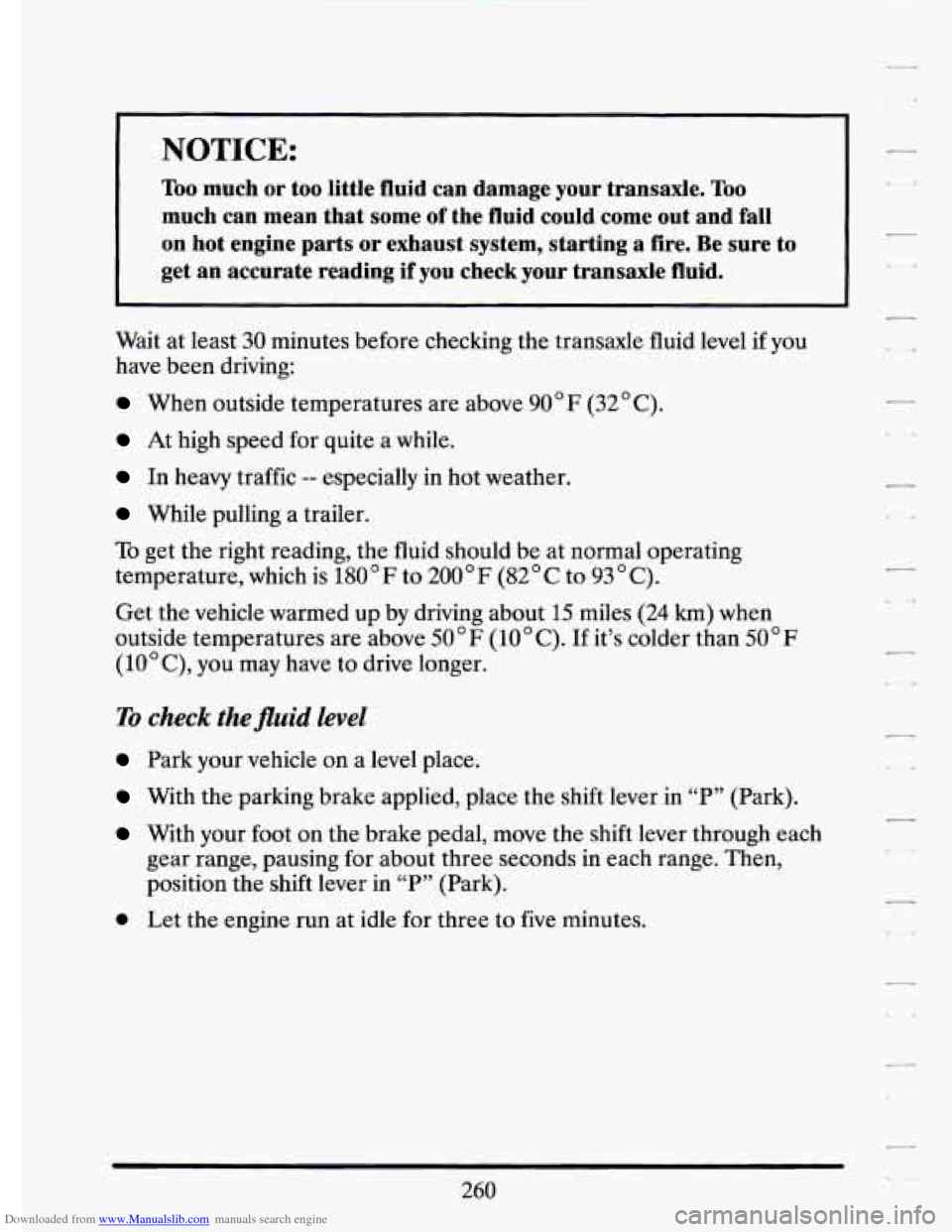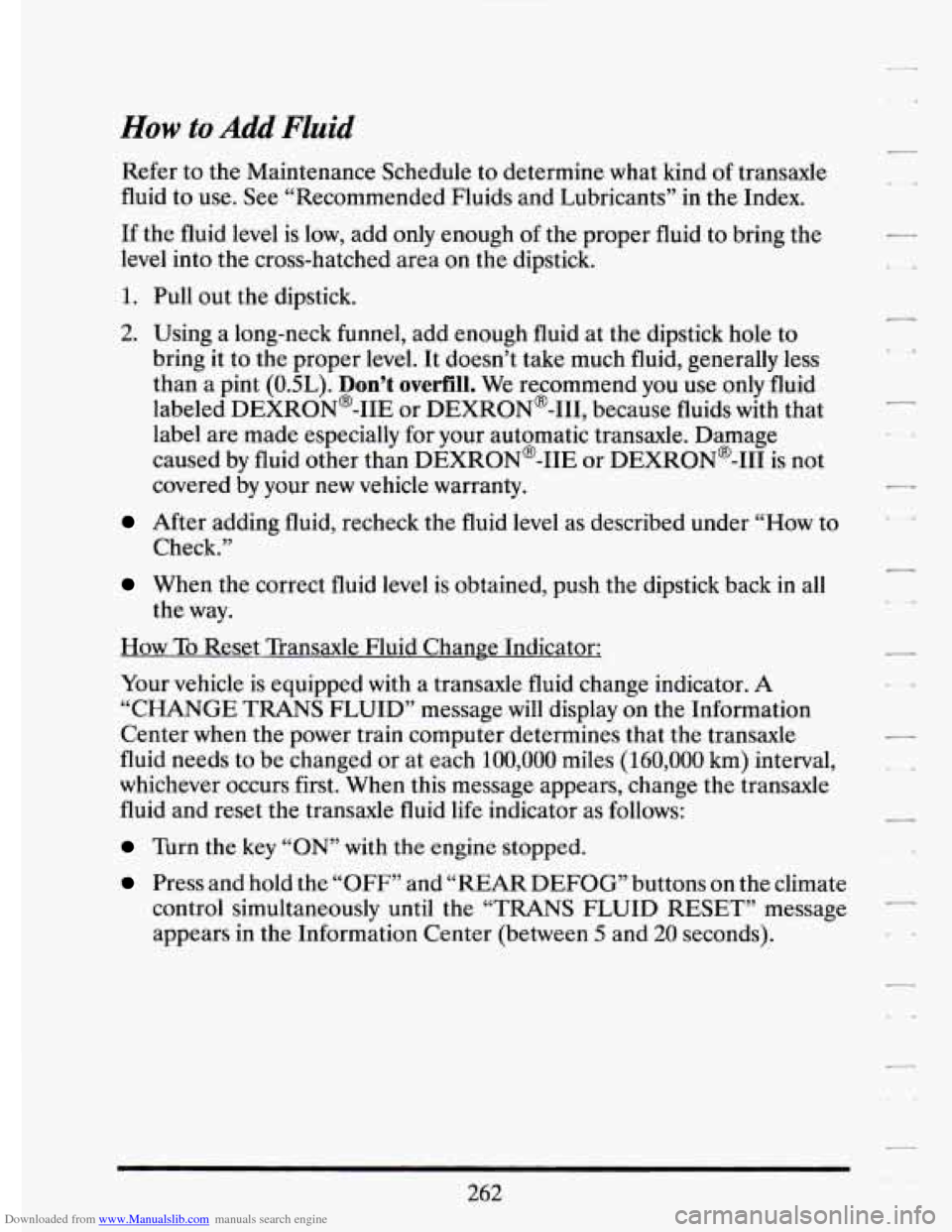Page 272 of 398

Downloaded from www.Manualslib.com manuals search engine NOTICE:
Too much or too little fluid can damage your transaxle. Too
much can mean that some of the fluid could come out and fall\
on hot engine parts or exhaust system, starting a fire.
Be sure to
get an accurate reading
if you check your transaxle fluid.
Wait at least 30 minutes before checking the transaxle fluid level if you
have been driving:
When outside temperatures are above 90'F (32" C).
At high speed for quite a while.
In heavy traffic -- especially in hot weather.
While pulling a trailer.
To get the right reading, the fluid should be at normal operating
temperature, which is
180 F to 200 ' F (82' C to 93 C).
Get the vehicle warmed up by driving about 15 miles (24 km) when
outside temperatures are above
50 "F (10'C). If it's colder than 50'F
(lO'C), you may have to drive longer.
To check the fluid level
Park your vehicle on a level place.
With the parking brake applied, place the shift lever in "P" (Park).
With your foot on the brake pedal, move the shift lever through each
gear range, pausing for about three seconds in each range. Then,
position the shift lever in
"P" (Park).
0 Let the engine run at idle for three to five minutes.
260
Page 273 of 398
Downloaded from www.Manualslib.com manuals search engine r
r i.
Then,. without shutting off the eyine. .. .follow . . these steps;
Tbm cap
counterclockwise
unlock cap. to
1. Pull out the
dipstick and wipe it with a clean rag or paper towel.
2. Push it back in all the way, wait three seconds and then pull it back out
again.
3. Check both sides of the dipstick, and read the lower level. The fluid
level must be in the cross-hatched area.
4. If the fluid level is in the acceptable range, push the dipstick back in
all the way.
r 1.
261
Page 274 of 398

Downloaded from www.Manualslib.com manuals search engine How to Add Fluid
Refer to the Maintenance Schedule to determine what kind of transaxle
fluid
to use. See “Recommended Fluids and Lubricants” in the Index.
If
the fluid level is low, add only enough of the proper fluid to bring the
level into the cross-hatched area on the dipstick.
1. Pull out the dipstick.
2. Using a long-neck funnel, add enough fluid at the dipstick hole to
bring it to
the proper level. It doesn’t take much fluid, generally less
than
a pint (OSL). Don’t overfill. We recommend you use only fluid
labeled DEXRON@-IIE or DEXRON@-111, because fluids with that
label are made especially for your automatic transaxle. Damage
caused by fluid other than DEXRON@-IIE or DEXRON@-I11 is not
covered by your
new vehicle warranty.
After adding fluid, recheck the fluid level as described under “How to
When the correct fluid level is obtained, push the dipstick back in all
Check.”
the way.
How To Reset Transaxle Fluid Change Indicator:
Your vehicle is equipped
with a transaxle fluid change indicator. A
“CHANGE TRANS FLUID” message will display on the Information
Center when the power train computer determines that the transaxle
fluid needs to be changed or at each
100,000 miles (160,000 km) interval,
whichever occurs first. When this message appears, change the transaxle
fluid and reset the transaxle fluid life indicator as follows:
Turn the key “ON” with the engine stopped.
Press and hold the “OFF” and “REAR DEFOG” buttons on the climate
control simultaneously until the “TRANS FLUID RESET” message
appears in the Information Center (between
5 and 20 seconds).
262
Page 277 of 398
Downloaded from www.Manualslib.com manuals search engine r
f-
r
r
To Add Coolant
If you need more coolant, add the proper mix at the coolant surce tank.
.~ . .
To Check or Add Coolant
When the engine is cold, remove the pressure cap from the surge tank,
use a flashlight as necessary to see into the tank. The coolant level should
be visible inside the tank about
2 112 inches (60 mm) below the base of
the fill neck.
If you need more coolant, add the proper mix.
SURGE TANK PRESSURE CAP
NOTICE:
Your surge tank cap is a 15 psi (1.05 kPa) pressure-type cap ana
must be tightly installed to prevent coolant loss and possible
engine damage
&om overheating. Be sure the arrows on the cap
line up with the overflow tube
on the surge tank filler neck.
I k
When you replace your surge tank pressure cap, an GM@ cap is
recommended.
b. I
265
Page 278 of 398
Downloaded from www.Manualslib.com manuals search engine THERMOSTAT
Engine coolant temperature is controlled by a thermostat in the engine
coolant system. The thermostat stops the flow
of coolant through the
radiator until the coolant reaches
a preset temperature.
When
you replace your thermostat, an AC@ thermostat is recommended.
POWER STEERING FLUID
How To Check Power Steering Fluid
Unscrew the cap and wipe the dipstick with a clean rag. Replace the cap
and completely tighten
it. Then remove the cap again and look at the
fluid level
on the dipstick.
266
Page 283 of 398
Downloaded from www.Manualslib.com manuals search engine R
&
Whenyour brake fluid falls to a low level, the ‘.‘CHECK BRAKE
FLUID” message will. display on the.Driver InformationCenter. and. your . . I
brake. warning light will come on. See “Brake System .Warning Light’% . i
the Index. 1
i ”0 Check Brake Fluid
7 Remove the cap. I 1
I‘
‘K i
r
r
1
,r
MAX FILL.
The fluid 1evel:must .be
line at the base of the
neck as’shok.
to the “MAX HI;.
,r ure the le!
above
‘“IN” and or slightly below or: at thi “MAX“ indicator.
After
work
is done on the brake hydraulic system, make SI ?el : is
When your brake fluid:falls
to a low level, your brake warning.light will
come’on. See “Brake System Warning Light” in the Index.
279
Page 303 of 398
Downloaded from www.Manualslib.com manuals search engine i
NOTICE:
.. - , .., .. . **:. 7 ' . ..._ ^ . ,
Don't let anyone tell you that underinflation or overinflation is
all right. It's not. If your tires don't have enough air
(underinflation) you can get:
Too much flexing.,
Too much heat
Tire overloading
0 Badwear
Bad handling
0 Bad fuel economy.
If your tires have too much air (overinflation), you can ger:
Unusual wear
Bad handling
Rough ride
0 Needless damage from road hazards.
How to Check
Use a good quality pocket-type gage to check tire
pressure. Simply looking at the tires will not tell
you the pressure,
especially
if you have radial tires -- which may look properly' inflated even
if they're underinflated.
If your tires have valve caps, be sure to put them back on. They help
prevent leaks by keeping out dirt and moisture.
When to Check Check your tires once a month or more.
The Eldorado tire pressures are:
0 Front - 28 psi (190 Pa)
Rear - 26 psi (180 kPa)
Page 305 of 398
Downloaded from www.Manualslib.com manuals search engine r,
1
r
r
f
I,
I-
r
r
that all wheel nuts are properly tightened. See “Wheel Nut Torque” in the
Index.
men It’s Time for New Tires
One way to tell when
it’s time for new tires is
to check
the treadwear
indicators, which
will
appear when your tires
have
only,2/32 inch
(1.6 mm) or less of
tread remaining.
Youneed a new
tire if:.
You can see the indicators at three or more -places around the tire.
You can .see cord or fabric showing through the tire’s rubber.;
The tread-or sidewall is cracked, cut or snagged deep enough to show
cord or fabric.
293 r